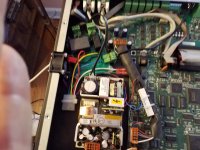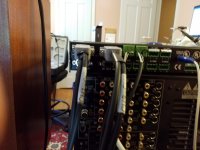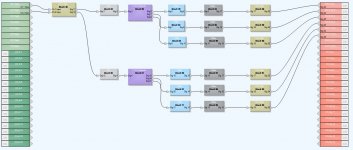I wouldn't make too much of it. Adjusting for a null is not an accurate way of bringing together your filters. You need a better view of what's going on over a wider range.
Hi mtidge, glad to hear you are making progress with the QSC basis unit.
Did the freq settings issue clear up with a firmware upgrade? Can you make specific freq adjustments?
Many prosound units of that era didn't have fine freq selectivity...but it sounds like kipman's processor from the same generation did have fine control..... ??
Anyway, yes, with LR2's the biggest null should occur with same polarity both drivers.
If not, acoustic center timing is off between drivers. That simple really....
It does pay to look in to this, ime...
otherwise it becomes the subjective hands in the air... i dunno, it doesn't matter haha
Did the freq settings issue clear up with a firmware upgrade? Can you make specific freq adjustments?
Many prosound units of that era didn't have fine freq selectivity...but it sounds like kipman's processor from the same generation did have fine control..... ??
Anyway, yes, with LR2's the biggest null should occur with same polarity both drivers.
If not, acoustic center timing is off between drivers. That simple really....
It does pay to look in to this, ime...
otherwise it becomes the subjective hands in the air... i dunno, it doesn't matter haha
I wouldn't make too much of it. Adjusting for a null is not an accurate way of bringing together your filters. You need a better view of what's going on over a wider range.
I only have a miniDSP UMIK-1, will I be able to make acurate timing measurements with a USB mic?
Thanks for the link, maybe this method will work for me, I haven't had much luck up to this point. Did you check your firmware version? I have the unit open again trying to add a trigger input, I reset all the connectors, maybe that will solve my output problem.
Hi mtidge, glad to hear you are making progress with the QSC basis unit.
Did the freq settings issue clear up with a firmware upgrade? Can you make specific freq adjustments?
Many prosound units of that era didn't have fine freq selectivity...but it sounds like kipman's processor from the same generation did have fine control..... ??
Anyway, yes, with LR2's the biggest null should occur with same polarity both drivers.
If not, acoustic center timing is off between drivers. That simple really....
It does pay to look in to this, ime...
otherwise it becomes the subjective hands in the air... i dunno, it doesn't matter haha
OK, I will try kipman's method to set the delays. As to the firmware, I can't find a place to download it other than what came with the Venue Manager, which is what I'm running.
I'm not saying your mic is inaccurate. However, looking at a null is not an accurate way to see how your drivers are in phase over the region of interest.I only have a miniDSP UMIK-1, will I be able to make acurate timing measurements with a USB mic?
Interresting, Cornwall looks really messy with Klipch passive setup.
I tried this method, it came very close to what I came up with by measuring reverse nulls. I set the spectrogram exactly as the article, it wasn't as clear but I was able to see the timing differences, I assume that because I'm measuring in my office there are a lot of reflections that make a mess. I'm done making cables for the DSP and retrofitting my speakers. I chopped up 8 Amazon Basics RCA interconnects and used up 50 feet of 12 gauge speaker, not to mention SeeakOns and Media Bridge banana plugs. I installed the trigger with delayed shutoff, at the same time I reseated all connectors and checked power supply voltage to every board. I noticed that the power supply is a standard Aztec LPT45, which is still available new for about $50.00. Still no V+ on the DataPort outputs. Today when I powered on the DSP wasn't receiving input signals and it kept disconnecting from the Venue application, I rebooted from Venue and it started working. I guess I will be picking up a spare on Ebay. Here are some pictures of the inside with the trigger on the left near the power supply, I should have used a smaller PC board. If anyone is interested in the trigger circuit I can post a parts list.
Attachments
I've used REW to set up my active system, but I don't have the equipment/don't know how to make trustworthy timing measurements. As a result, I've tried a few different test sginals and adjust by ear. None of these are orginal. Method A is easiest.
(A) invert polarity of one channel and adjust for deepest null with pink noise at x-over. This won't tell you which speaker is earliest, but what I read about x-overs, the HF usually is advanced so I used that as a basis for setting delays.
(B) Make a custom test signal, a sine wave burst at your x-over. For example, My MF/HF is at 1000 Hz. I used Audacity to make a 1000-Hz sine only about 10 ms long, the rest silence for a 1 sec wav file. Then play this looped as you adjust the delays, from my desired listening position. Adjusted for quietest signal.
(A) invert polarity of one channel and adjust for deepest null with pink noise at x-over. This won't tell you which speaker is earliest, but what I read about x-overs, the HF usually is advanced so I used that as a basis for setting delays.
(B) Make a custom test signal, a sine wave burst at your x-over. For example, My MF/HF is at 1000 Hz. I used Audacity to make a 1000-Hz sine only about 10 ms long, the rest silence for a 1 sec wav file. Then play this looped as you adjust the delays, from my desired listening position. Adjusted for quietest signal.
Why do people think the information and methods for doing an active crossover is any different to the passive methods we've been always doing? The speakers haven't changed...
Timing is seen/included with phase. Does it line up the way we want it too? Make it line up. If you want to use the method of measure, adjust, measure, adjust.. then you'll get it there. No need to measure timing on its own.
Timing is seen/included with phase. Does it line up the way we want it too? Make it line up. If you want to use the method of measure, adjust, measure, adjust.. then you'll get it there. No need to measure timing on its own.
@AllanB Hello my namebrother. Would you be so kind as to make a short simple tutorial about this and link to it in this thread? I am converting a set of Dali 18 mk 2 to active. My crossover is an insanely cheap DBX without time-delay so it would be very beneficial for me and others if you could mention how to (BSC?) delay a driver after highpass/lowpass if that is possible. Is it posible at line-level between crossover between crossover and amplifier would be nice to know too. Hope it wont be too much time-consuming.
Cheers!
Cheers!
Thank you for your interest. I am working on a tutorial for this, it is very long and takes much time to do.
I would still be happy to assist you if I can.
I would still be happy to assist you if I can.
I picked up another Basis 922az on E-bay. I can confirm some of the things I mentioned in a previous post.
I stated the the subnet mask is fixed in IP settings on ControlNet, this isn't accurate, the IP stack does not support CIDR, it appears only to support classful routing.
I also tested the DataPort outputs and the new unit only outputs on the V- pins, there is no signal on the V+ Unless there is some setting I can't find then my opinion is the QSC 922az has balanced outputs, put not differential outputs.
The new unit still has the course granularity for frequency on filters and cross-overs I mentioned earlier.
Despite the issues I mentioned I'm satisfied with the product for the price. I think I prefer the sound with the active vs. the passive, but I can't say it is night and day.
Here is a picture of the design I'm using.
I stated the the subnet mask is fixed in IP settings on ControlNet, this isn't accurate, the IP stack does not support CIDR, it appears only to support classful routing.
I also tested the DataPort outputs and the new unit only outputs on the V- pins, there is no signal on the V+ Unless there is some setting I can't find then my opinion is the QSC 922az has balanced outputs, put not differential outputs.
The new unit still has the course granularity for frequency on filters and cross-overs I mentioned earlier.
Despite the issues I mentioned I'm satisfied with the product for the price. I think I prefer the sound with the active vs. the passive, but I can't say it is night and day.
Here is a picture of the design I'm using.
Attachments
Very odd that even if just impedance balanced the output is on the V- leg as conventionally it would be on V+. I haven't got my QSC to behave correctly apart from briefly (alas I think its borked) and the other QSC basis are at my friends yard so haven't had chance to check this.
In the meantime I have been using a Biamp Nexia VC (4 outputs), the Biamp Nexia are even cheaper than the basis units (I paid £25) and the fan is temperature controlled (inaudible over my pretty quiet PC), the connectors are also standard plugable terminals. Multiple units can be networked together to get more IO, the AEC inputs can have the AEC turned off to work as standard line level inputs. I'm pretty pleased with it so far; only a few negatives:
1) delay through the unit is not fixed
2) software workflow is strange, you have to be disconnected from the unit but connected to the 'network' to flash a new DSP design to the unit
3) no multichannel (even stereo) blocks so you have to copy and paste the blocks rather than just change once
4) super ugly flow graphs
5) if an existing design relies on other nexia units connecting to the unit will throw up loads of errors
6) IP address (if not known) has to be changed via serial port connection
7) AFAIK no digital input versions of the unit are available, however metering is excellent and the units have output step attenuators so its very easy to optimize the gain structure of the system. I was able to easily exceed the SNR of my power amps (no difference in speaker noise with DSP connected/disconnected.
In the meantime I have been using a Biamp Nexia VC (4 outputs), the Biamp Nexia are even cheaper than the basis units (I paid £25) and the fan is temperature controlled (inaudible over my pretty quiet PC), the connectors are also standard plugable terminals. Multiple units can be networked together to get more IO, the AEC inputs can have the AEC turned off to work as standard line level inputs. I'm pretty pleased with it so far; only a few negatives:
1) delay through the unit is not fixed
2) software workflow is strange, you have to be disconnected from the unit but connected to the 'network' to flash a new DSP design to the unit
3) no multichannel (even stereo) blocks so you have to copy and paste the blocks rather than just change once
4) super ugly flow graphs
5) if an existing design relies on other nexia units connecting to the unit will throw up loads of errors
6) IP address (if not known) has to be changed via serial port connection
7) AFAIK no digital input versions of the unit are available, however metering is excellent and the units have output step attenuators so its very easy to optimize the gain structure of the system. I was able to easily exceed the SNR of my power amps (no difference in speaker noise with DSP connected/disconnected.
They way I look at it with two of them only putting out one signal then they are not differential. As to V- only, maybe the cable diagram I found is in correct and it is actually the V+ the only way I can find out is to compare a low frequency input to the output. Hi frequency won't tell because of the delay inside the device. Maybe I will check someday.
Another very powerful DSP option are the Ashly Protea units 4.24C and 4.24D. These are routinely showing up on eBay for under $200. Four inputs and eight outputs provide a lot of options. Gain structure is the issue with these as they are +4db units but then most all of the commercial grade units are.
The 4.24C or 4.24D units are four in by eight out. The Cs have XLR connections and the D units have Phoenix plugs. There is is also a slight difference in how channel assignments are handled between the two but the filter hardware and software are the same. Another difference is that the C versions can be programmed from the front panel and programs can be selected from the front panel. On the D units you must use a computer for programming. You can download the Windows programming software from their site.
- Home
- Loudspeakers
- Multi-Way
- Going Active What DSP should I use?


